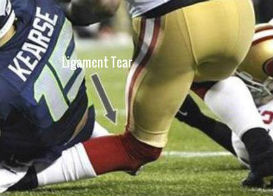Dr. Raj Kanna is a consultant Orthopaedic and Knee surgeon, who have made a mark in the field of Orthopedics with his success stories.
The knee is a complex joint between the femur (thigh bone) and the tibia (shin bone). The anterior cruciate ligament (ACL) is placed centrally within the knee joint and is made of bundle of tissue fibers. It runs from the back of the thigh bone to the front of the shin bone.
_html_602f2b7c2.jpg)
It is one of the main stabilizing ligaments in the knee and acts to prevent forward movement of the tibia. Further the ACL stabilises the knee during rotational movements like twisting, turning and sidestepping.
The ACL helps in controlling the rotational forces developed during landing from a jump. Also, it sends feedback to the brain providing information regarding the position of the knee and its balance.
_html_602f2b7c1.jpg)


ACL can be injured if the knee is bent backward, twisted, or bent side to side. During sports the injury can happen when the foot is firmly planted on the ground and a sudden force hits the knee (contact type) or this can happen when the player is changing direction rapidly, slowing down when running, or landing from a jump (non contact type).
Recent evidence shows that most of these injuries are non-contact and do not involve a collision with another player. This type of injury is common in soccer, skiing, football, and other sports with lots of stop-and-go movements, jumping, or weaving. Falling off a ladder or missing a step on a staircase are other likely causes for ACL tear.
A tearing or popping sensation is frequently reported at the time of ACL tear and immediate swelling is common due to bleeding from the ruptured ligament.When ACL is torn, the information regarding joint position and balance it carries is also lost and the knee may feel as if it is unstable or giving way.
Normal walking becomes difficult and sometimes painful. Sometimes the knee can get locked and so it becomes difficult to bend or straighten the knee freely. Because of the instability, there is a risk of injury to other structures of the knee joint such as the meniscus or the cartilage.
Unlike other ligaments about the joint, the ACL passes through the joint and is surrounded by joint fluid. The joint fluid prevents blood clotting which is essential for scar formation. While the other ligaments heal by scar formation, without blood clot and scar tissue formation the ACL fails to heal.
_html_m3ec626ca.jpg)
An MRI (magnetic resonance imaging) scan is not absolutely essential to diagnose an acute ACL tear as an accurate and detailed history and clinical examination is more reliable.
MRI can however confirm the diagnosis and give additional information on injuries to other ligaments and structures within the knee. On MRI the normal ACL appears as a continuous dark band (Picture A). If damaged there is disruption (Picture B) or complete absence of this band (Picture C).
_html_1859b952.jpg)
_html_m291bd412.jpg)
Although there is good correlation for diagnosis MRI scanning is not 100% accurate. Occasionally an examination under anaesthetic and arthroscopy ("key-hole surgery") is necessary to confirm the diagnosis of ACL tear.
Non-operative treatment with braces and exercise usually fails. These patients frequently have "giving way" episodes with tearing of other structures, such as the meniscus and the cartilage. This may lead to arthritis (wear and tear) of the knee joint later in life.
_html_41fa1cd6.jpg)
The ACL will not heal by itself and it is not possible to repair a torn ACL. Hence, an alternative tissue (graft) must be used to replace it. Using the patient's own tissue is by far the preferred way to reconstruct the torn ACL. With advance in technology we routinely do this through key-hole technique. There are multiple advantages to this technique such as a) less blood loss, b) less pain, c) early recovery, d) less tissue damage, e) lesser chance of infection, f) more cosmetic, etc. After surgery patient has to undergo physiotherapy for three to six months following which he or she will be able to do all activities which they were doing before the injury including elite sports.
_html_mf0cd68d.png)